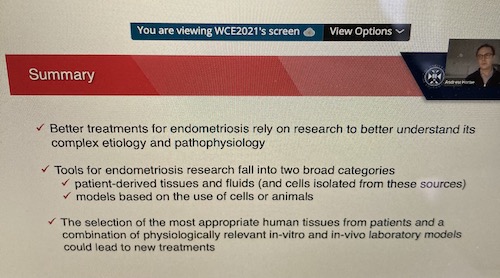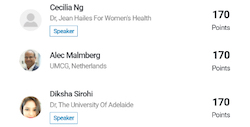The 14th World Congress on Endometriosis kicked off today in a positive and progressive mode
Having had to be moved three times due to COVID-19, WCE2021’s virtual platform has proven an instant hit — not least because sections of the congress are scheduled in different time zones ensuring all delegates can attend LIVE at least some of the time!
All content will be available on demand within 24 hours every day to LIVE registrants, and available to “on demand only” registrants from 11 March through 11 April 2021.
Welcome to WCE2021
WES President, Neil Johnson, “unmasked” WCE2021 earlier today, and bid 634 delegates from 51 countries welcome:
Professor Johnson proceeded to remind everyone that, whereas the World Endometriosis Society is best known for incomparable world congresses on endometriosis, WES leads the way in international collaborative efforts to improve standards of care for those affected by endometriosis and adenomyosis:
Joint WCE2021 presidents, Cong-jiang Xu (China), Arnaud Wattiez (UAE), and Sun-Wei Guo (China) all sent their heartfelt wishes for a successful meeting, and encouraged everyone to enjoy themselves and let the science speak!
Experimental models in endometriosis
The main conclusion from the seminar on experimental models, which was moderated and chaired by Dingmin Yan (China) and Erin Greaves (United Kingdom), was that
“All experimental models are wrong’”, but they are also vital for our research into endometriosis pathophysiology and testing of potential therapeutics.
-

Today’s winners of the “leaderboard” – those that were most active at WCE2021 on day one. Prizes will be sent directly and everyone entered into the final prize draw on day 5!
Data from Caroline Appleyard (Puerto Rico) in a rat model indicate that exercise as a complementary therapy might alleviate endometriosis symptomalogy by modulating the HPA-gut axis and immune modulation.
- Ayako Nishimoto-Kakiuchi (Japan) compared spontaneous vs induced endometriosis in cynomolgus monkeys.Those with spontaneous endometriosis exhibited superficial lesions. Monkeys with surgically (sutured) induced endometriosis developed nodular and cystic lesions, however when endometriosis was induced using minced and seeded tissue superficial lesions and adhesions developed. This is important because it suggests that in models animals different subtypes might be induced using different techniques.
- Maria Yarmolinskaya (Russia) demonstrated how a rat model of endometriosis can help us understand how Vitamin D supplementation may improve endometriosis symptoms.
- Ana Carolina Rosa-e-Silva (Brazil) presented data in a mouse model showing decreased recruitment of bone marrow derived stem cells to the eutopic endometrium and preferential recruitment to endometriotic lesions.
- Finally, Sebastian Schäfer (Germany) presented 3D spheroids to model the early endometriotic lesion and how it invades tissue. This approach promises to be useful as a tool for screening small molecule drugs and miRNA-based approaches.
Said Erin Greaves:
We are still a way off being able to use complex organoids that can truly recapitulate authentic interactions between the peritoneal lining and ectopic endometrial tissue and for example the nervous system.
However, the future is bright for the development and use of organoids and as a community we should pursue this approach in combination with enhancing in vivo models.
Adenomyosis
This session, moderated and chaired by Sun-Wei Guo (China) and Ludwig Kiesel (Germany) where discussion could have gone on for hours, concluded that:
The veils of pathogenesis and pathophysiology of adenomyosis are now being partially lifted thanks to our grip of the natural history of adenomyotic lesions, Iatrogenic uterine procedures have been experimentally demonstrated to increase the risk of adenomyosis through the disruption of the endometrial-myometrial interface, but perioperative intervention may reduce the risk.
The progression of adenomyosis would increase the fibrotic content in lesions, which is propagated into the neighbouring junctional zone and then endometrium, impairing endometrial repair, leading to heavy menstrual bleeding.
The diagnostic accuracy can be improved by elastography. However, the pathogenesis of adenomyosis is complex and likely multifactorial. There are still much more to be unearthed in this regard.
Cannabinoids in endometriosis
Cannabis (and its derivatives) has been used for hundreds of years to treat pain. Millions with endometriosis around the world are using cannabis whether legal or not.
 In the last 10 years we have gained an understanding both of the complexity of the endogenous cannabinoid system – its receptors, ligands, and regulation of levels by enzymes – as well as its importance in the reproductive system and its dysregulation in endometriosis.
In the last 10 years we have gained an understanding both of the complexity of the endogenous cannabinoid system – its receptors, ligands, and regulation of levels by enzymes – as well as its importance in the reproductive system and its dysregulation in endometriosis.
Yuval Kaufman (Israel) and his colleagues are conducting systematic testing of different combinations of cannabinoids to develop a formula that can be used as a reliable therapy – one of the key features of this work is the validation of vaginal delivery systems (gels/suppositories).
Said Philippa Saunders (United Kingdom):
Their work and that of others show cannabinoids are effective in treating endometriosis-related pain and lay the groundwork for more widespread use of this therapy including in countries where access is currently restricted by legal constraints.
Yuval Kaufman concluded:
Cannabis is a wonder plant that has the potential to treat all aspects of endometriosis both at the cellular level (inflammation, cell migration, anti-proliferation, anti-fibrosis, anti-oxidation) and clinically (pain, GI symptoms, sleep disorders, and more).
Cannabis, however, also has side effects and hazards that we need to be aware of when attempting to compose the right formulation. Local vaginal administration may be better for reducing systemic effects.
Those with severe pain should be allowed access to cannabis based formulations for their symptoms.
Addressing endometriosis-associated infertility
In this session, made possible with financial support by Guerbet, Neil Johnson (New Zealand), Andrew Horne (United Kingdom), and Velja Mijatovic (The Netherlands) showed how lipiodol HSG has a marked beneficial effect in those with endometriosis-related infertility. The key take-home messages were:
- As well as tubal flushing, lipiodol exerts immuno-biological effect on endometrium and peritoneum.
- In vitro and in vivo models can give laboratory evidence of endometriosis disease modifying candidates.
- New data mandate a fresh look at fertility treatment algorithms for treating endometriosis related infertility that further hinge on tubal latency, pain complaints, response to hormone treatments – and adenomyosis should be considered.
Please note: Not all products referenced in these presentation are approved or commercialised in every market and approved labelling and instructions may vary from one country to another. Please refer to your local SmPC.
Young WES
Young WES was established two years ago and comprise 25 “young ambassadors“, of which six are on the Young WES Board.
 This energetic group of upcoming leaders in endometriosis have been actively involved in shaping WCE2021, including all of the networking activities (fireside chats, brain exchanges, interactive poster sessions, etc)
This energetic group of upcoming leaders in endometriosis have been actively involved in shaping WCE2021, including all of the networking activities (fireside chats, brain exchanges, interactive poster sessions, etc)
Young WES has established a mentoring programme, which is being kicked off at this congress with two mentoring sessions:
- Sunday 7 March at 12.30 UTC
- Monday 8 March at 20.30 UTC
There will also be a session on Tuesday 9 March, to hear your thoughts on what you want from Young WES between now and 2023 …and beyond
Young WES have contributed widely to the establishment of WESinars: grand rounds and round tables.
A favourite summary today?

Andrew Horne (United Kingdom) summarising the needs in endometriosis
Missing out?
It is not too late to join WCE2021 LIVE — register here AND enjoy on demand content through 11 April 2021. Attending LIVE means being able to interact with peers: Q&A and discussion in all sessions, fireside chats with keynote speakers, and brain exchanges on selected topics — and there are four more days to go!



